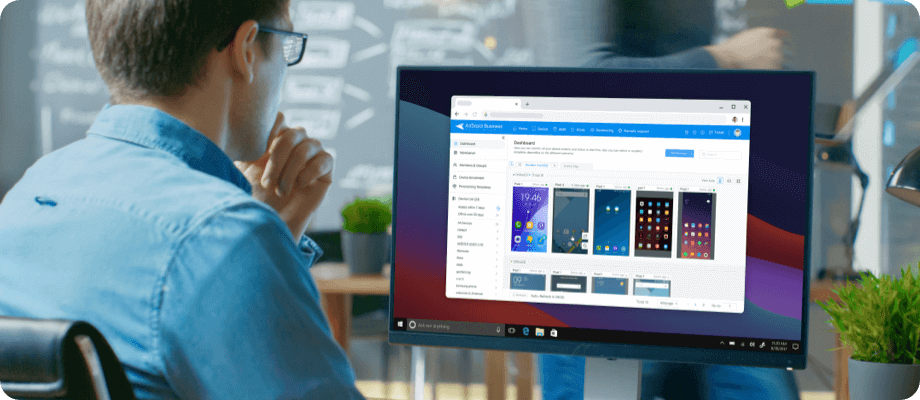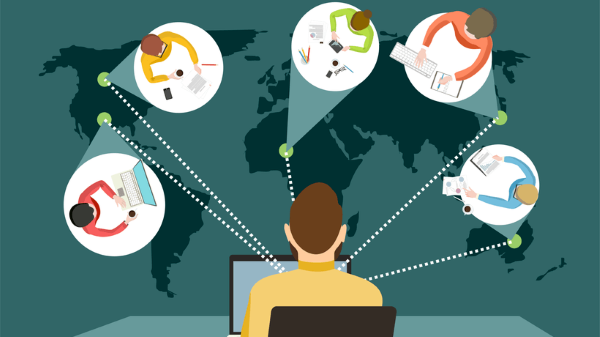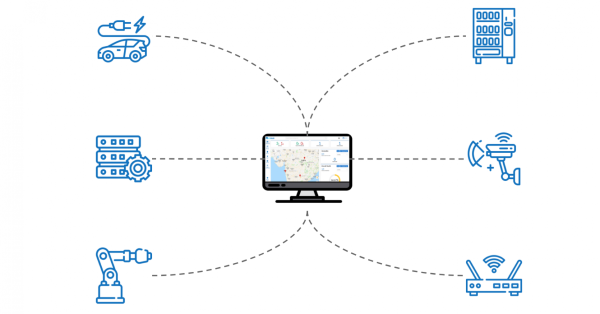Remote Device Management: Purposes, Tools and Benefits
Today, businesses and organizations are more reliant than ever on different types of devices. However, managing a high number of devices, especially when they are not all located in the same space. This is where remote device management solutions come into play.
They are an essential tool for all organizations looking to streamline their operations and secure their networks by enabling IT admins to monitor, control, update, secure, and troubleshoot devices from any location.
In this article, we’re exploring what remote device management is, its purposes, tools, advantages, and more.
1What is Remote Device Management?
Remote device management refers to monitoring, maintaining, and controlling multiple devices in use in the same business, organization, or network, from a distance and using specialized software tools.
The devices that can be managed with these tools can range from mobile devices, such as smartphones and tablets, to desktop computers, and IoT devices.
The purpose of remote device management is to provide a centralized dashboard to manage devices that are geographically dispersed.
There are multiple types of Remote Device Management solutions:
- MDM: Specifically designed to manage mobile devices, such as mobile phones, tablets, and – in some cases – laptops. MDM solutions allow admins to control all devices, enforce policies on them with automatize processes, install applications, block other applications, and so on. MDM solutions can be implemented with organization-owned devices and in BYOD (Bring Your Own Devices) programs.
- UEM: This is Unified Endpoint Management and extends the capabilities of MDM to other types of devices including desktop computers, wearables, and in some cases sensors. Just like MDM, UEM also provides a single platform from which all devices can be configured, controlled, monitored, updated, and secured.
- IoT Device Management Platforms: These are specialized to manage IoT (Internet of Things) devices. These can include different types of sensors and equipment, home and industrial machines, and appliances. IoT platforms can enroll all these devices and allow admins to control them from a single dashboard from which they not only control the functioning of the productive line (for example) but also maintain, update, and troubleshoot it.

Overall Remote Device Management includes some main features:
- Centralized management of multiple devices: Remote device management solutions provide a single dashboard from which admins can control every device that has been enrolled (potentially, every device in use in the business).
- Device Configuration: When devices are enrolled within the RDM platform, they can be configured and updated from the RDM software itself. Both enrollment and configuration can happen in bulk, meaning that there is no need to configure devices one by one.
- Device Lockdown: From the RDM tool, every device can be locked or blocked when needed. For example, when an employee loses or gets stolen their device, the admin could block it instantly to avoid any loss of data or security threats.
- Device Location Tracking: From the main dashboard, any device in the network can be located. This enhances security, helps manage operations, and has other advantages.
2What Are the Purposes of Implementing A Remote Device Management Solution?
Device used by remote employees
In many businesses, employees need devices for their work. In some cases, they are provided by the company, in other cases, employees use their own devices.

Challenges: With all these devices accessing the company’s data, even when outside the company’s buildings, how can it ensure full security, prevent unauthorized access, and make sure that every employee has the necessary software tools to work?
Remote Device Management is the solution: from a single and comprehensive dashboard, an IT admin can monitor all devices, and the applications installed, update and control them. By setupping alerts to detect abnormal device behaviors, they would also be able to spot unauthorized access and perform security actions, like disabling USB periphery connection, to prevent damage.
Devices distributed in public areas
Many public areas, like festivals, shopping malls, squares, fairs, and others, use devices to display information and ads or to provide simple services. These devices include digital signage, self-service kiosks, monitors, and more.

Challenges: How to manage them all from a single platform, making sure they keep working according to the administration’s needs.
Remote Device Management is the solution: With RDM, IT teams are able to control the content displayed on each screen and device, and update it, manually or automatically, when needed.
The platform also allows them to monitor their performance, notify malfunctions, to make sure that everything works smoothly across the public space.
IoT Devices
IoT devices are sensors and other devices that are usually part of a bigger network that provides a comprehensive service to the company or public. For example, an IoT ecosystem can be utilized in a transport company to track vehicles, their fuel levels, and their drivers’ driving style, and to manage the fleet across the country.

Challenges: The IoT sensors within a single ecosystem can be many. The challenge here is to keep an eye on all this information coming from so many sensors and devices, elaborate data, and provide the most appropriate response.
The Remote Device Management solution can carry out this role in the most efficient way.
3Remote Device Management Tools for Different Strategies
In Part 1, we explored the various types of Remote Device Management solutions in depth. Additionally, the commonly used strategies for managing devices are BYOD and COBO.
The first strategy (Bring Your Own Device) refers to a working environment where collaborators and employees use their devices for work purposes.
The Corporate-Owned Business Only strategy, instead, refers to environments where the company provides their employees and collaborators with the devices they need for their work.
Here, we will introduce some remote management tools tailored for COBO and BYOD strategies for enterprises to consider.
COBO:
AirDroid Business is compatible with all Windows and Android devices; it means that all Android mobile phones, tablets, laptops, and Windows desktop computers can be enrolled within the platform. Its main features are the following:
- Remote access: AirDroid Business allows IT administrators to remotely connect to and control enrolled devices, regardless of their location. Remote access also allows admins to control devices in real-time: they can troubleshoot them, install new software, update existing applications, and they can also continuously monitor devices to prevent malfunctions and solve issues as soon as they are manifested.
- Policies assignment: This feature allows admins to create, assign, and enforce policies across the enrolled devices. These policies can include security patches, usage restrictions, app management, and more.
- Kiosk Mode: This feature can turn Android devices into dedicated-purpose tools. How does it do so? By restricting access to non-essential applications and settings.
AirDroid Business is ideal for COBO environments, where the company has provided all collaborators and employees with the devices they need for their work.
BYOD:
For managing devices in a BYOD scenario, Microsoft Intune is a good choice, as protecting company data on employees' devices is a primary concern. Intune offers key features such as:
- IT Support & Troubleshooting: Enables remote monitoring, device report viewing, issue diagnosis, and prompt resolution.
- Security and Compliance: Provides access control with strong authentication methods like MFA (Multi-Factor Authentication), encrypts data during transmission and at rest, and allows IT to remotely wipe devices.
- Privacy Control: Separates corporate and personal data to ensure employee privacy and security.
4Advantages of Remote Device Management Solutions
Remote device management, with all its features, provides a lot of advantages to the companies that deploy it.
Proactive Monitoring
The possibility of accessing devices remotely, monitoring them in real-time, and setting personalized alerts in case particular events occur, allows the company to have a proactive approach.
A proactive approach is one that’s aimed at preventing issues instead of acting only when the problems have already occurred. Preventing issues guarantees that the workflow is never interrupted, optimizing productivity and reducing costs.
For example, it is very common for a company to deploy an IT network made of mobile devices, computers, and servers.
When one or more of these devices fail (for example, a server goes accidentally offline, or an application installed on employees’ devices isn’t updated and starts performing slowly and badly) this can bring issues to the company: the workflow slows down and, in some cases, it could stop until the issue is fixed.
With proactive monitoring, all the above-mentioned possible issues are prevented and continuity is guaranteed.
Efficiency and Time Savings
One of the main advantages brought by Remote Device Management software is the possibility of bulking a lot of actions such as device enrollment, updates, security policy assignments, and so on.
Bulking actions mean performing the same action on multiple devices, without the need to repeat it for each of the devices within the IT ecosystem.This feature can save businesses and IT teams a lot of time, even for simple actions.
Let’s take the example of taxi companies: after a day of work, they need to shut down the onboard devices on every vehicle to save battery power and extend the equipment's lifespan. Doing this manually, one device at a time, would be time and energy-consuming.
With an RDM centralized dashboard, they can give one command and with that perform the same action (shutting the onboard devices down) would be repeated for all devices or groups of them.
Security
With a Remote Device Management software tool, device compliance policies ensure that every device connected to the company's network adheres to predefined security standards.
These policies can enforce measures such as mandatory encryption, regular updates, and password complexity requirements.
For instance, in a company that issues smartphones and laptops to employees, non-compliant devices could pose significant security risks, such as data breaches or unauthorized access to sensitive information.
By implementing compliance policies, the company can automatically monitor and enforce security standards, ensuring that all devices are secure and reducing the risk of potential vulnerabilities.
Simplified Management Process
Last but not least, a Remote Device Management software tool helps companies and organizations simplify the management process.
The remote app management feature, for example, allows IT admins to install, update, and remove applications across multiple devices without needing physical access to each device.
As we’ve seen in the previous paragraph, furthermore, these actions can be performed in bulk, making the process even more efficient.
To make a use case example, when a critical update is required for a sales app used by a remote workforce, instead of relying on individual users to manually update their apps, IT can push the update remotely to all devices simultaneously.
5Deploy, Monitor, Control and Secure Devices Remotely
With almost any business that exists relying on a diverse array of devices across different locations, remote device management becomes a key component of IT networks and ecosystems.
By implementing RDM solutions, organizations can efficiently deploy, monitor, control, and secure their devices, ensuring that their networks remain robust and resilient.
RDM tools like MDM and UEM offer comprehensive management capabilities that streamline operations, enhance security, guarantee continuity, and reduce costs.
In doing so, they not only protect the integrity of the organization's data and systems but also contribute to a more efficient and productive working environment, easing the overall management process.









Leave a Reply.